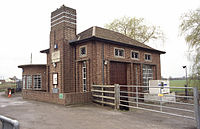- Curry and Hay Moors
-
Curry and Hay Moors Site of Special Scientific Interest 
Curry Moor Pumping StationArea of Search Somerset Grid reference ST323273 Coordinates 51°02′28″N 2°58′01″W / 51.04105°N 2.96701°WCoordinates: 51°02′28″N 2°58′01″W / 51.04105°N 2.96701°W Interest Biological Area 472.8 hectares (4.728 km2; 1.825 sq mi) Notification 1992 Natural England website Curry and Hay Moors (grid reference ST323273) is a 472.8 hectare (1168.1 acre) biological Site of Special Scientific Interest in Somerset, notified in 1992.
Curry and Hay Moors form part of the complex of grazing marshes known as the Somerset Levels and Moors. The low-lying site is situated adjacent to the River Tone which annually overtops, flooding the fields in winter. Soils are predominantly alluvial clays overlying Altcar series peats. The flora and fauna of the ditches and rhynes is of national importance. Over 70 aquatic and bankside vascular plants have been recorded including Frogbit (Hydrocharis morsus-ranae), Flowering Rush (Butomus umbellatus), Wood Club-rush (Scirpus sylvaticus) and Lesser Water-plantain (Baldellia ranunculoides). Over 100 species of aquatic invertebrates inhabit the ditches including one nationally rare soldier fly, (Odontomyia ornata) and 13 nationally scarce species including the water beetles Agabus uliginosus, Hydaticus transversalis and Helophorus nanus.
In winter the flooded fields provide food for large numbers of waterfowl with several thousand Lapwing (Vanellus vanellus), hundreds of Snipe (Gallinago gallinago) and smaller numbers of Golden Plover (Pluvialis apricaria) and Dunlin (Calidris alpina) regularly present. Over two hundred Bewick's Swans (Cygnus bewickii) have been recorded, making the site an internationally important wintering ground for this species. Raptor species such as Short-eared Owl (Asio flammeus), Merlin (Falco columbarius) and Peregrine (Falco peregrinus) regularly hunt over the site in winter. Vertebrate species present include Grass Snake (Natrix natrix) and Common Frog Rana temporaria. Otters (Lutra lutra) are regularly recorded on the site.[1]
References
- ^ "Curry and Hay Moors". English Nature. http://www.english-nature.org.uk/citation/citation_photo/1003576.pdf. Retrieved 2006-08-12.
Categories:- Sites of Special Scientific Interest in Somerset
- Geography of Somerset
- Sites of Special Scientific Interest notified in 1992
- Somerset Levels
- Wetland Sites of Special Scientific Interest
Wikimedia Foundation. 2010.

